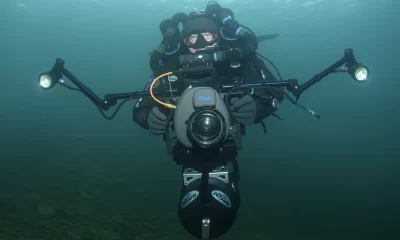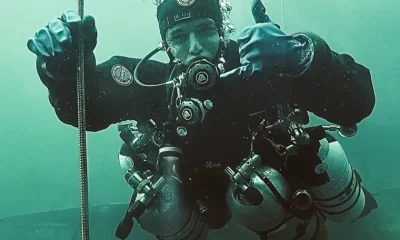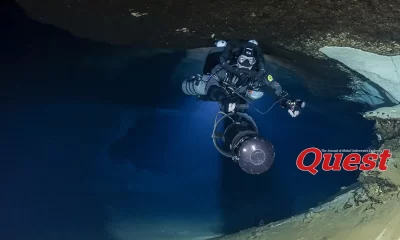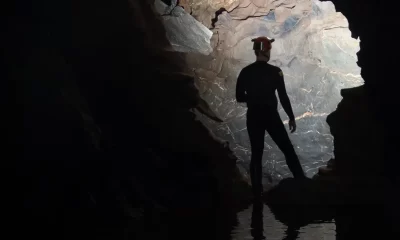Community
The Who’s Who of Sidemount

Michael Thomas
Michael Thomas is the Training Officer of the British Cave Diving Group (CDG) Somerset Section. The CDG is credited with being the first organization to develop sidemount diving in the early 1960s. Mike is an avid promoter of sidemount and cave diving and he is also a Full Cave instructor, and a sidemount and tech instructor with TDI. In addition to being a Fellow of the Royal Geographic Society, he is on the British Cave Rescue call list.
What is sidemount to you?
Sidemount is a tool for a job underwater. There I said it, now let me backup a bit and explain. I have been a dry caver or speleologist since I was a child. Both my parents are also cavers. I started diving in 1987 and started cave diving in 1992. Now if you start cave diving in the UK with the Cave Diving Group (CDG ) you also start sidemount diving. My first cave dive in Hurtle Pot Cave in the Yorkshire Dales in 1992 was also my first sidemount dive. I was taught cave diving and sidemount diving by a core of four divers, one lady and three gentlemen that had learnt to sidemount cave dive in the 1980s. As a diver I work and play underwater with a variety of tools; an HSE Full face mask, open circuit, CCR and sidemount. I try to use the best tool for the dive. Sometimes its Sidemount sometimes itʼs not.
What can be improved in sidemount in general?
Sidemount equipment has had many and significantly good changes over the years. Itʼs also had many equipment and training disasters, but thatʼs another story! If we take the sidemount community as a complete package, the one thing I would like to see improved is less of the self righteousness from some parts of the social media world. We all need to learn that shouting down at divers who are not in perfect spirit-level trim needs to stop. Sidemount has many varied skill sets and equipment and if itʼs not what you learnt on your course, itʼs not always wrong.

Was there an epiphany moment for you with sidemount?
The magic moment for me was not the ability to transport equipment easily underground or being able to move easily in low cave passage. These things just happened naturally as sidemount was what we used to cave dive. However, the first time I used a xDeep Classic harness with the ability to place weights down the spine of the harness rather than around the waist like a classic CDG harness, it was the game changer for me. No more back ache from pressure on the lower spine and better trim overnight. Iʼm not sponsored by xDeep or have any financial involvement with the company, but they have changed the game in my opinion. I still use my xDeep harness today.
Whatʼs the main difference between an early day British sidemount diver and a modern one?
Traditional sidemount divers in the UK such as CDG members are actually not much different from CDG divers active today. Our system and harness is designed with dry caving in mind and passing through sumps (flooded cave passage ) to reach the next dry section. Our sidemount systems are designed to drop cylinders along the way or use any cylinder needed. Also we carry equipment used for dry caving beyond the flooded section. Ropes, drilling equipment and camping gear if required. All of this goes on the harness.
Traditional UK CDG divers are commonly diving wetsuits and not much interested in a perfectly organized and trimmed out cylinder configuration. We have a job of exploration to do and take what is required. Steel cylinders are common, aluminum are easily damaged transporting through the dry sections. We also use karabiners instead of bolt-snaps for attaching the cylinders. Karabiners still work when covered in mud and you should not use a bolt-snap as a weight loading device when lowering cylinders in vertical dry cave.
What has gotten better with sidemount and what got worse ?
The choice of good sidemount harnesses for the various different styles is now excellent. Regulator setups with the correct length LP and HP hoses also makes diving life so much more streamlined.
Whatʼs gotten worse? Too many manufacturers offer poorly designed harnesses because they think they must add sidemount to their product line.
So you have to tell the unwitting student that bought one, they have a suboptimal harness that wonʼt work the way they think it will.
What makes a good sidemount diver?
Making good sidemount divers is very subjective and each diver will have strong opinions. In my world, having a sidemount diver that can use and work the traditional CDG system for cave exploration and travel, and also have the technical skill set of a modern day sidemount diver with great trim and buoyancy is the best. In addition to floating around looking at nice stuff, they need to be able to work and explore.
Return to: The Who’s Who of Sidemount
DIVE DEEPER
Speaking Sidemount: Episode #25 – British Cave Diving & the CDG with Michael Thomas
InDEPTH:Meet The British Underground By Michael Thomas
InDEPTH: Dem Bones, Dem Bones, Dem Wookey Bones By Michael Thomas
The Big Scuba: Fathers Day Scuba Special with Michael & Robert Thomas diving team -Father and Son make great team

















































